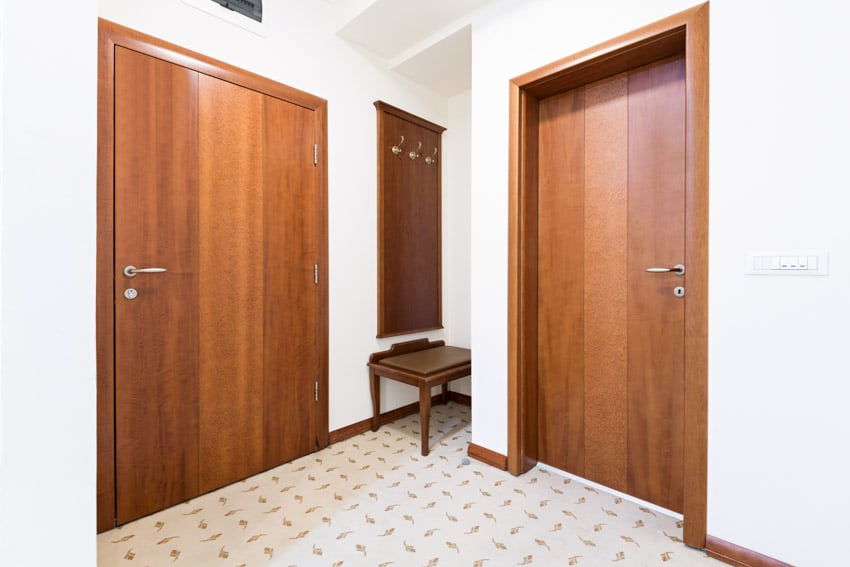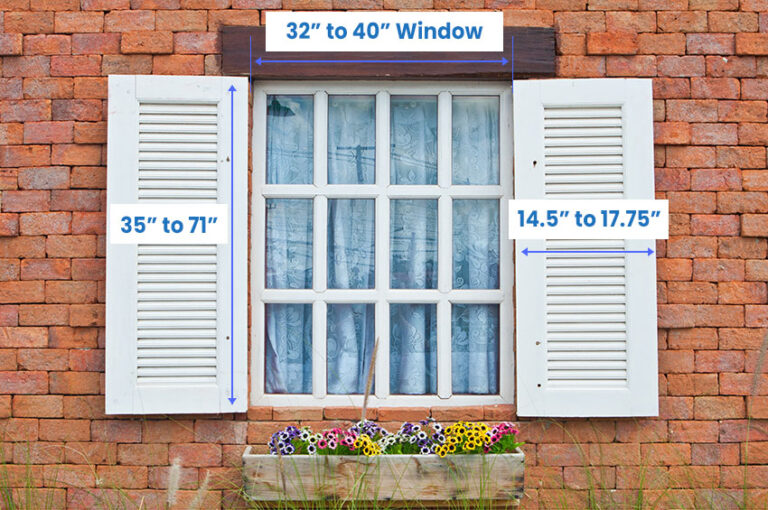What Is A Door Jamb? Different Types & Extending Tips

A door jamb refers to the posts on both sides of the door frame, forming parallel vertical parts. These posts build a strong frame to attach the door to the structure or home. And this frame is the strong foundation that holds the weight of the door using its hinges, which makes a door jamb a vital part of the durability and safe operation of the door.
These door jambs on the door’s both sides are called strike jambs and hinge jambs. The former is located on the same side of the doorknob and is where the door strikes, which is how it got its name. On the other hand, the latter is located on the other side where the hinges are, which is also why it is called a hinge jamb.
Door jambs are commonly made of the material that the door is made of. If the door is wood, it’s only logical to have a wooden door jamb too. The similarity in materials will make it easier to conduct repairs whenever needed. But door jambs are not just limited to wood. They can also be made of galvanized steel. Some people prefer galvanized steel door jambs because they are weatherproof. These door jambs can also be customized to match the overall appearance of your home.
Door jambs can be seen in different types of doors, from standard single doors to double doors and sliding and folding doors. The door jambs need to be plumb and perfectly vertical to ensure the door functions well. They also need to have accurate measurements, where both jambs need to have the same length that’s not too narrow or too tall and strictly follow the 90-degree angle. Going outside this angle will lead to the door not bolting properly or rubbing on the door frames.
Door Jamb Types
For door jambs, there are a few different types you can look into. These rabbeted, split, and flat jambs. Whether you’re dealing with an interior or exterior door will help determine the type. Here are some door jamb types you need to consider.
Rabbeted Jambs: More common in interior doors, rabbeted door jambs are popular in bathroom and bedroom doors.
They have a recess or ‘rabbet’ that runs on the inside edge of the jamb. A rabbet is a groove carved on the wood to close and lock it. These door jambs are involved with the side of the door where the rabbet is located. They help seat the door flush with the jamb to provide privacy.
Usually built-in, here are two types of rabbeted jambs:
• Single rabbet door jamb: Holds a single door
• Double rabbet door jamb: holds two doors/one door + one screen (with opposing egress)
Split Jambs: Ideal for doors with a thicker interior wall frame, split jambs have two split parts to make it easier to install a standard-sized door even with this rough frame. These are the ideal option for older homes with irregular thickness.
Similar in appearance to a flat jamb, the two pieces of a split jamb have a tongue and groove design that helps to make them fit well together. They are more affordable and usually offered to the market with pre-attached door casing.
A successful casing job also depends on how well the door jamb was installed. – Doors, Taunton Press
Flat Jambs: To cater to simple and uncomplicated doors, flat jambs work well. They feature a standard measurement and come with a separate door stop.
These will help avoid the door from going through the frame. They are also considered more structurally stable and so can carry heavy-duty doors.
Door Jamb Vs Door Frame
People usually interchange the door jamb with the door frame and vice versa, but they actually refer to two different things. A door jamb is only a part of a door frame, and the door frame is incomplete if it only has a door jamb.
A door frame usually features a combination of horizontal and vertical parts, all placed on the door’s sides to provide enough support for its operation. This includes the following elements:
• Head
• Sill
• Door jamb
On the other hand, a door jamb is only 50 percent of the door frame. It runs vertically on both sides of the door frame and takes the door’s weight through hinges, hardware, and striker plate on the other side for opening, closing, and locking. This door frame section also helps keep it stable and square in shape.
How To Measure A Door Jamb
One of the crucial things about adding and installing a door jamb is getting accurate measurements. The jambs need to have similar heights and not too tall or short compared to the door to work effectively.
Consider these simple steps when accomplishing this task:
Step 1 – Prepare all tools and supplies: All you need to do is take out a tape measure, along with a paper and pen to write down measurements and mark the wood or metal you’re installing.
You can also prepare the following tools to get these sizes and measurements.
• Saw
• Sandpaper
• Utility knife
• Wood shims
• Jamb kit
Step 2 – Take note of the appropriate measurements: Here are some standard and common measurements for door jambs.
• Height: 80 inches
• Width: 28 to 36 inches
• 2×4 frame with stucco or thick drywall: 5 ½ inches
• 2×4 frame with ½ drywall: 4 9/16 inches
• 2×6 frame: 6 9/16 inches
• Deadbolt hole: 7/8″ or more in diameter and at least 1″ deep
Step 3 – Prepare the door jamb for measuring: Before measuring the door jamb, make sure to take out the siding or trim molding on the door. If you do not remove the molding, it will give you an erroneous measurement. Once you clean that up, you can finally start measuring.
How To Extend A Door Jamb
Door jambs need to have an accurate measurements for the pieces of the posts to function effectively. Many of them are pre-structured to fit the standard width of walls, which can either be 2×4 inches or 2×6 inches. You would also need to consider the common ½ inch types of drywall located on each side of the wall.
While these measurements are standard, some walls can be thicker than others either because they are just made that way or because of the addition of cladding layers. And in these cases, you might need to extend the door jamb for it to fit perfectly.
Here are the steps to help you extend your door jamb.
Step 1 – Get the right measurements: Get your tape measure and start measuring from the jamb’s edge to the drywall’s face. This will be the measurement of the jamb extension you must add.
Take time to learn how to measure a door jamb from different spots and use the biggest measurement you get.
Step 2 – Cut the jamb extension to its width: Cut your jamb extension and start on its width using a 1×4 saw. Use a table saw and a tape measure to make everything easier.
Step 3 – Cut the length of the jamb extension: After you cut the jamb extension by its width, start cutting it to length. Measure up to the top jamb and use that for the length of your extension.
Step 4 – Glue the extension to the door jamb: Once you’ve cut the jamb extension to the right dimensions, put it in place by applying glue to the back of the extension and placing it in the door jamb. Ensure the extension’s face is flushed with the jamb’s side.
Step 5 – Nail the extension to the door jamb: Finally, nail through the extension into the door jamb to fully secure it. Use finish nails that can penetrate the door jamb at least an inch even when they pass through the extension.
If you have a door threshold it is often installed against the jambs and fit in below the stops.
Video on Installing a Door Jamb
What Is A Split Jamb Door
A split jamb door is a term that refers to the type of door jamb that comes in two symmetrical pieces and is split along the middle. The pieces are then fitted together again by sandwiching them at the front and back of the doorway’s casing. This is how it got its name in the first place.
It is the preferred type of door jamb for the following instances:
• The rough frame of the interior wall is wider than the standard opening
• The pre-hung door does not fit
• If you want a quick and easy installation and the price is not an issue
Usually manufactured by specialist companies, the split jamb can come fully assembled and ready to be installed. They can be expensive when you rely on the contractor services of a construction company for the installation, but they are also guaranteed to have high quality work and convenient installation.
What Is The Difference Between A Split Jamb And A Flat Jamb Door?

This means that more than just knowing about the right measurements, you should also know if you will need a split jamb or a flat jamb.
And if you need help identifying each, here is a quick glance at the differences between a split jamb and a flat jamb.
Split Jamb Vs Flat Jamb
Split Jamb
• Attached to the edge of the jamb
• Ideal for complicated and rough frame
• More affordable to install
• More versatile and customizable
• Easy and speedy installation
• Supports less level of weight
Flat Jamb
• Flushed against the frame
• Ideal for standard and heavy-duty doors and frame openings
• May be costly
• Need to stick strictly with its structure
• Takes time to build
• Better structural integrity and so more secured
With all these differences laid out, you will better grasp what type of door jamb can help you better with your needs and requirements.
What Is The Advantage Of Split Door Jambs?

• Fast and speedy installation: Split door jambs can be hung and placed in less than 10 minutes.
• Versatile in its installation: With two smaller pieces you can use, you can place them in different types of doorways whether they are thick or thin. They can even be adjusted when needed.
• More cost-effective options: Split door jambs come at more affordable prices, and since split door jambs are easier to install, you also can save a lot by skipping on professional fees.
With all of these advantages, ensure you know the disadvantages on the other side. Some of these include the tendency of split door jambs to misalign and they are even prone to damage.
What Is A Hinge Jamb?
A hinge jamb refers to one of the main vertical components of the door frame. A pair to the strike jamb which carries the strike plate and the locking mechanism, the hinge jamb carries the door hinges which will allow the door to be attached to the structure.
Since it will fully carry the door’s weight, this door jamb needs to be sturdy and strong. It also needs to be durable enough to withstand the regular wear and tear of repeatedly swinging the door open and close.
See more related content in our article about the different front door sizes on this page.












